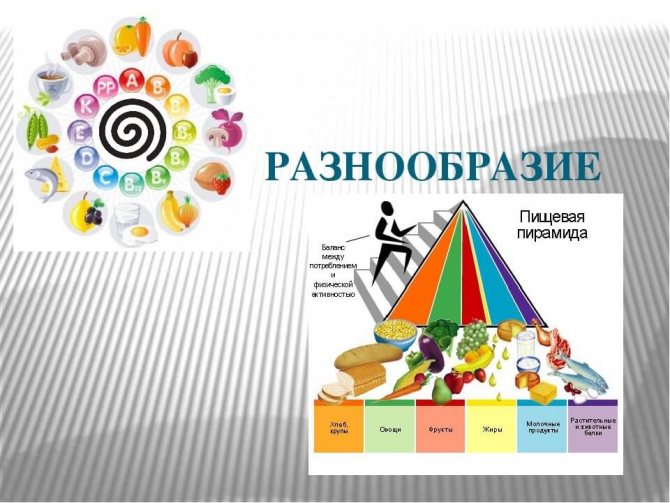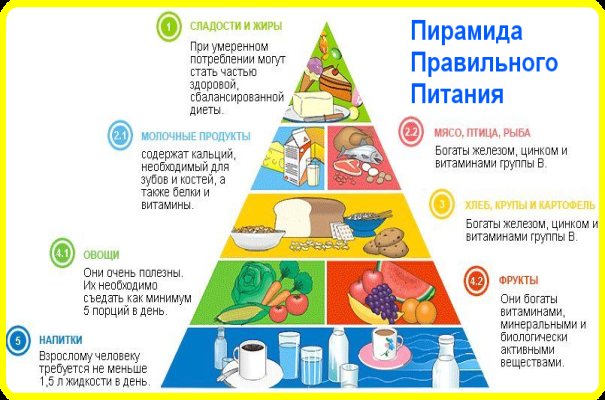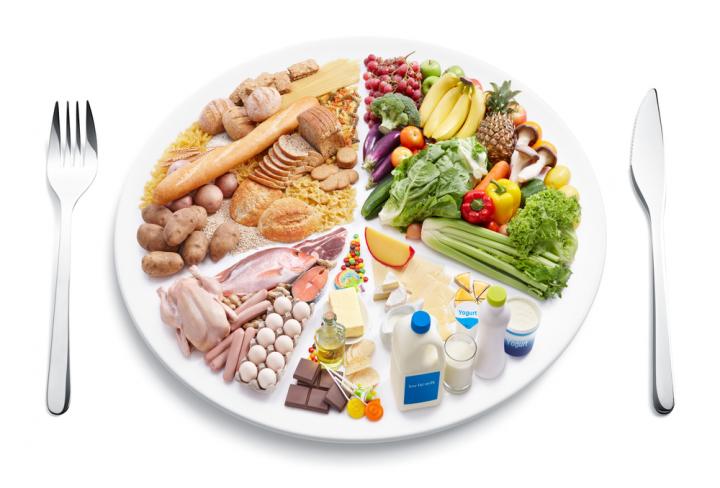The concept of rational nutrition
First of all, the essence of the term should be identified.
A balanced diet is one that ensures the normal functioning of people. This type of providing the body with food can even have a preventive effect. The main thing is to take into account individual characteristics. These include: gender, age, work characteristics, physical activity. Do not ignore climatic conditions. The climate greatly affects your well-being. For this reason, it is important to select a menu that will not cause discomfort. This issue needs to be studied thoroughly.
You should become familiar with the power functions in detail. This will help you organize it correctly and avoid unforeseen consequences.
Other principles of the food pyramid and the basic conditions for its maximum effectiveness
In addition to the principle of diversity, the following principles are also characteristic of the food pyramid:
- The principle of proportionality. The point is that it is necessary to adhere to the correct ratio of foods consumed. In the diagram, this rule is reflected in the different widths of the segments. For example, the yellow segment of fats is the narrowest, which means that fats should occupy the very last place in the diet.
- The principle of individuality. Each person is individual. Moreover, this includes not only his gender, age, body structure, but also food preferences. The food pyramid will help you create an individual healthy diet.
- The principle of moderation. The correct diet is not only about the quality of the foods consumed, but also about their quantity. Moderate consumption means not overeating or starving.
- The principle of physical activity. This principle creates a parallel with other principles and is represented by the formula: varied food + physical activity = beautiful and healthy body. We'll talk about this principle in more detail a little later.
The food pyramid should not be taken as some kind of rigid guide to nutrition. From all the variety of products, everyone can create a suitable healthy menu for themselves. And the maximum effect of the health pyramid will only be achieved if the following conditions are met:
- Maximum combination of products.
- Balancing food intake with physical activity.
- Minimizing products from the top of the pyramid.
- Strict adherence to the choice of products from a specific group - there should be no substitution.
- Consume only fresh foods, avoiding prepared foods.
- A competent approach to purchasing products by studying their nutritional value and production date.
Power functions
The most important functions include:
- filling the body with energy. A balanced diet allows you to balance incoming and outgoing energy. Thanks to this, a person always feels good and does not complain of fatigue;
- saturating the body with useful substances (proteins, fats, carbohydrates, minerals). Over time, the cellular structures of the body are destroyed. It is necessary to form new ones. This becomes possible thanks to the incoming nutrients. They are the ones who contribute to the formation of new cellular connections;
- improvement of the immune system. People's immunity directly depends on the quality of food consumed. Therefore, it is recommended to eat exclusively healthy foods.
What levels does the food pyramid consist of?
The basis of the food pyramid is the most useful foods that bring maximum benefit to the human body. If the average caloric intake of a healthy person is 2000–2200 kcal, then the pyramid will look like this.
Main food groups:
I. At the base of the pyramid are potatoes, bread, grains, pasta and other slow carbohydrates. Products you need to choose are whole grain:
- whole grain bread;
- brown pasta;
- unpolished cereals (brown and wild rice, buckwheat, oatmeal, etc.);
- whole grain flour.
These products contain more fiber and essential microelements.
Basics of rational nutrition
Adherents of a healthy lifestyle need to know everything about the basics of balanced nutrition. This will solve a lot of questions. Which foods should you eat and which should you avoid? How often should you eat? What size portions are required? What to cook for dinner? Understanding the basics of nutrition and following the main principles of eating habits guarantee a fulfilling life. So what are the basic principles we are talking about?
Moderation
Everyone needs to learn how to maintain a balance between the energy value of consumed products and the energy consumed in the process of life. This is the only way to feel comfortable and maintain a normal weight. You should not assume that a large serving size will provide the body with the necessary calories. It is not always so. Small portions of foods that are too high in calories can cause excess energy. This excess is often short-lived. This is also harmful to health.
When choosing food, you should also take into account individual characteristics. Plus, men should consume more calories per day. Women need less. The energy value of children's dishes should also be quite high. After all, children lead an active lifestyle.
Diversity
A varied diet has a positive effect on the body. By consuming various high-quality products, people saturate themselves with 70 different substances. The daily diet should contain fats, carbohydrates (including fiber), proteins, vitamins, and minerals. But the ratio of these components should vary significantly. The diet of adults with average physical activity should include:
- 90 grams of proteins;
- 100 grams of fat;
- 400 grams of carbohydrates.
A lack of nutrients can worsen your health and cause malaise. Therefore, it is important to ensure that the necessary chemical compounds are supplied in sufficient quantities daily.
Compliance with the regime
Rational eating habits imply that people should adhere to a certain diet. Otherwise, you can significantly worsen your well-being. After all, without a systematic intake of food, the body will experience stress after stress. Due to irregular nutrition, extra pounds may soon appear.
Experts recommend eating food 5 times a day in small portions. It is important to avoid uncontrolled snacking. They greatly increase your total daily calorie intake. Ideally, there will be three main meals a day and about two planned snacks. Between meals you need to maintain a time interval of approximately three to three and a half hours.
Rules for rational nutrition
When creating a menu, you need to focus on the “food pyramid” developed by nutritionists. It indicates exactly how to form eating habits and which specific products to give special preference to. When developing proper nutrition for the day, week or month, you need to be guided by the following:
- your daily diet should include grains. They contain healthy fiber, vitamins;
- per day you need to eat at least 450 grams of fresh fruits, vegetables, herbs, legumes;
- calcium can be obtained from milk;
- It will be useful to include fish, lean meat, eggs in the menu;
- It is better to choose olive oil;
- consume fast carbohydrates and sugars as little as possible. They can cause negative changes in the body;
- daily salt intake – maximum 6 grams;
- It is important that the food is natural.
Proper diet: how to make it?
The definition of the concept “diet mode” is as follows: it is a qualitative and quantitative characteristic of nutrition (time of intake, frequency, calorie content, chemical composition, human eating behavior).
If a person practices the correct diet, then his body receives the nutrients necessary for life in a timely manner. Food has a direct impact on well-being, appearance, performance and overall health. The fact that poor nutrition can provoke a weakened immune system , impaired mental and physical development, as well as a decrease in performance, is also emphasized by the WHO - World Health Organization.
Therefore, when forming the right diet for children and adults, some very important points should be taken into account. When planning your daily diet, it is important to consider several factors.
Nutrients
micronutrients and macronutrients are in the foods consumed .
Protein, carbohydrates, fats and fiber are macronutrients. Calculation of how many of these substances a person needs is based on height, age, weight, lifestyle characteristics and energy expenditure. If we talk about averages, a person should get about 10-20% protein from food, about 10-30% fat and 50-70% carbohydrates. Accordingly, excess protein, fats or carbohydrates are harmful to the body.
Vitamins and minerals are micronutrients. Currently, scientists identify more than one hundred micronutrients contained in food. But the most important for the body are 13 vitamins and 15 minerals. With their deficiency, pathological conditions can develop.
Water
Part of a balanced diet is water. For the body, this is an “essential” product. It is important not only for life, but also for the process of losing weight, since water accelerates the breakdown of fats. Therefore, you should drink up to 2 liters of water per day. There is a special formula for calculating its amount in the daily diet. A woman needs to drink an amount of water at the rate of 30 ml per 1 kg of body weight, a man - 35 ml per 1 kg of body weight. People who play sports should take special care of their water balance.
Calorie content
This indicator determines the amount of energy produced in the body when consuming food. Calorie content and nutritional value are different concepts. The latter determines the amount of carbohydrates, fats and proteins in foods. When compiling a diet, it is necessary to choose low-calorie foods that still have high nutritional value. Protein products are important, since protein is the main “building” material in the body. The benefits of meat and fish for the body are undeniable - these are one of the main sources of proteins.
A balanced and healthy diet requires that a person’s energy expenditure and food intake must be adequately compared. That is, the daily caloric intake should be such as to provide, but not exceed, energy expenditure.
When compiling a diet, it is necessary to take into account the so-called “empty calories”, which are absolutely useless for the body. After all, such products provide energy for a very short period and do not contain important nutritional components. The result of their frequent and excessive consumption is excess weight. Therefore, it is very important to choose desserts correctly, ignoring sources of “empty calories” - soda, pastries, and confectionery. However, you shouldn’t give up desserts completely. The importance of desserts for a person lies, first of all, in receiving pleasure from such food. And a properly selected dessert (fruits, dishes made from low-fat cottage cheese, fermented milk desserts) may well be the conclusion of a tasty and healthy meal.
Peculiarities
The basics of rational nutrition do not imply uniform rules. Each case is individual. For this reason, you need to study your body. This will allow you to understand what microelements and other compounds he is currently lacking. This awareness will help you competently create a daily menu. This approach will protect against unpleasant consequences.
Age
There are three age groups. For each of them, experts have developed special nutritional recommendations:
- Children need to consume much more calories per day than adults. This is due to the fact that the child’s body is developing. This requires exclusively useful substances. Along with this, the high physical activity of children should be taken into account. To restore the expended energy, they need to eat quite heavily. The average daily energy value for children is 2,000 calories (with moderate activity);
- Adults should consume about 3,000 calories during the day with moderate activity;
- In older people, metabolic processes slow down significantly, and physical activity also decreases. For this reason, people of advanced age should reduce the calorie content of meals to 2,000 kcal per day.
Gender
If you want to replace old eating habits with more correct ones, you need to focus on gender differences. Men need to eat meals with higher energy value and high protein content. This is due to the structural features of the male body and working conditions. The life activity of men involves daily physical activity, often very strenuous. It is for this reason that they need to restore expended energy. To do this, you need to eat the most high-calorie foods.
Women should eat less. Their body is designed a little differently. As for physical activity, it practically does not require large amounts of energy. 2,200 kcal per day with a predominance of fats is quite enough. Such a quantity will allow you to restore both strength and the reproductive system.
Climatic
It is important to remember one basic rule here: the lower the air temperature, the more calories people need to consume. That is, eat more high-calorie foods. What is the explanation for this? With the onset of cold weather, metabolism worsens. Additional energy is required to restore the body. High temperatures are the most familiar and comfortable for people. Therefore, the calorie content of dishes in favorable climatic conditions should not be increased.
Target
If you have a goal to lose weight, then you should reduce your daily calorie intake. However, everything needs moderation. There shouldn't be a big calorie deficit.
When exercising regularly, try to increase the calorie content of your food so that your body does not experience stress. This way, productivity will not drop, and you will not feel weak.
Should you give up your evening meal?
Many people wonder what dinner should be like with proper nutrition? Or is it not recommended to have dinner at all? You should not skip meals in the evening. Otherwise, there may be discomfort in the abdominal area, even fatigue. However, there is no need to overeat before bed either. It’s ideal if you can eat something light for dinner. One option is a vegetable salad dressed with olive oil. You can eat it with a small piece of fish. A healthy dinner is the key to good health.
Diversity of the food pyramid
The food pyramid is based on five basic principles. The main one is the rule of diversity, which means that you can eat anything you want in the absence of allergies and contraindications. Moreover, each product group corresponds to its own color.

Orange
Includes all grains: from bread to cereals. The group is rich in vitamins, minerals, dietary fiber, vegetable protein and low in fat. You should eat six servings of grains every day. In the diagram, orange occupies the largest share; accordingly, grains should predominate in the diet. In this case, preference should be given to bread with bran and rolled oats.
Perhaps six servings sounds like an unrealistic number. But, if you consider that one serving of the same porridge is 100 g, then a full breakfast plate of 400 g will already take four servings, plus a slice of bread and a couple of cookies. Here are all six servings, as if it never happened.
Green
Presented with all types of vegetables. Three to five servings per day will be enough. In this case, the diet should be formulated in such a way that it contains a portion of yellow, orange or green vegetables containing beta-carotene.
Red
Fruits, berries, as well as vegetables, are sources of beta-carotene, vitamin C, folic acid and other vitamins and microelements. They are also rich in plant fiber and organic acids. You will need 2-3 servings of fruit per day, one of which should be citrus fruit.
You can also drink juices, but fresh fruit is still preferable, since it retains plant fiber and contains less sugar. Both fruits and vegetables should be varied. For example, if on Monday it is a banana, then on Tuesday it is an apple and so on.
Yellow
The narrowest strip represented by fats. Moreover, vegetable fats are a priority. They even form the base of the pyramid. The small width of the strip is associated with saturated fats, which many people abuse. So, you need to minimize butter and margarine, confectionery fat. Otherwise, you can develop problems with the cardiovascular system.
Blue
All dairy products are rich in vitamins, microelements and are a source of complete animal proteins. They also contain lacto and bifidobacteria, which are so necessary for our intestines. You should consume 2-3 servings of dairy products daily.
Violet
Presented with plant and animal proteins. You will also need 2-3 servings per day. Moreover, one of them should consist of plant proteins, for example, nuts or legumes, and the other two - from animals - meat, fish, eggs. It is better to choose lean meat, and it is better to avoid sausages and sausages altogether. It is also better to choose low-fat fish varieties.
Popular recipes
When creating a menu, most people are faced with the following questions: “What is healthy to eat for dinner?”, “What should dinner be like with proper nutrition?”, “Can I have meat for dinner?” and the like. What's the secret to the perfect evening meal?
Below are popular dinner recipes with proper nutrition.
Boiled breast with Greek salad.
For the salad you will need:
- cucumber;
- tomato;
- bell pepper;
- lemon juice;
- olives;
- Chees Feta;
- vegetable oil.
Preparation: cut ingredients, mix. Season the salad with oil and add lemon juice. Serve with boiled chicken breast.
Buckwheat cutlets with pumpkin.
Required:
- buckwheat (200 grams);
- one and a half glasses of water;
- 150 grams of pumpkin;
- greenery;
- breadcrumbs.
Preparation:
- boil buckwheat;
- grind the pumpkin (to a puree);
- Form cutlets from buckwheat porridge and pumpkin puree and bake in the oven (20 minutes).
MyPyramid - updated pyramid
The food pyramid developed by the Ministry of Agriculture had disadvantages and was criticized by nutritionists and doctors. The Center for Nutrition Policy and Promotion took the comments into account and updated the information and presented a new diagram. MyPyramid is a nutrition pyramid used from 2005 to 2011.

The schematic image has changed significantly. Food groups are depicted as ascending vertical bars. In this way, correct proportions of food items were emphasized. The image of a man climbing the stairs emphasized activity. To strengthen physical and mental health and stay fit, adults should devote at least 30 minutes a day to sports, children (students) - at least an hour.
Description of the product pyramid
Cereals are the basis of nutrition. Wheat, rice, oats, barley and corn flour, buckwheat (porridge). Amaranth, quinoa, sorghum, millet, rye and triticale. Pasta, bread, oatmeal, breakfast cereal. Crackers, tortillas, and other products made from grains are included in this group. Grains are divided into two categories, whole grains and refined grains.
MyPyramid recommends that at least half of the grains a person eats daily be whole grains.
Whole grains use the whole kernel, including the bran and germ, or grind it into flour. Examples of whole grain foods: bulgur, brown rice, wild rice. And also oatmeal, whole grain bread, pasta, muesli, popcorn.
Vegetables or juices from them. MyPyramid recommends that people eat vegetables from five subgroups.
Subgroups:
- dark green vegetables: spinach, kale, watercress, turnip greens, bok choy, broccoli, collard greens and similar vegetables;
- orange: vegetables - carrots, sweet potatoes, butternut squash, squash, acorn squash, etc.;
- different varieties of beans: black, navy, lima, broad beans. Black-eyed peas, chickpeas, lentils, tofu (bean curd), etc;
- starchy: vegetables - potatoes, corn, fresh Lima beans, green peas;
- other vegetables: artichokes, cauliflower, mushrooms, bean sprouts, onions. Nightshades: eggplants, peppers, tomatoes. Celery, iceberg lettuce and vegetables not classified elsewhere.
Fruits can be fresh, canned, frozen or dried. One hundred percent fruit juice is also considered a fruit. Citrus fruits, berries, melons. Apples, bananas and pears, dried fruits.
Milk – Skim, low-fat and whole milk contain about the same amount of calcium. Low-fat and low-fat milk are the preferred options in this group. Other foods in the milk group include yogurt, cheese, and desserts made with milk such as ice cream and pudding. When choosing foods such as ice cream, full-fat cheese or sweetened yogurt, excess calories from fat and sugar must be subtracted from the daily calories allowed.
Proteins. The basis of the group is meat and beans. People should eat less red meat and more fish, poultry, legumes, nuts, and seeds.
Oil and fats in the healthy human nutrition pyramid are shown as a thin strip. Oil is consumed in small quantities. Preference is given to vegetable ones: corn, olive, safflower. Fats also come from plant foods - avocados, nuts, olives.
Expert opinion
According to the classical definition, “rational nutrition is a diet that ensures growth, normal development and vital activity of a person, helps improve his health and prevent diseases.” Accordingly, eating irrationally means both having a systematic lack of some nutrients and having too much of them. What is overshoot and undershoot? This is most conveniently explained in terms of the units of heat in which the nutritional value of foods is measured: calories. When they are consumed in food and drink more or less than the norm, a person becomes fat or loses weight. If a person does not have such goals, then he must eat rationally, that is, without excess calories and nutrients, and without their deficiency. Because both obesity and weight loss too often lead to poor health and illness.
So, rationality means the exact correspondence of the provision to the needs. And they are individual for everyone. How can you find out exactly your unique indicators (what and how much do you need)? By contacting a weight loss specialist. In general, I think they should be called differently: specialists in its normalization, since they can help their patients not only lose weight, but also gain the correct number of kilograms. It all depends on each specific case.
Harvard pyramid (plate) of nutrition for a healthy person
In 2011, a new pyramid was developed. MyPlate is a plate-style nutrition guide with five food groups.

In the diagram, the circle is divided into 4 parts. Unlike the previous pyramids, the amount is indicated as a percentage of the total food consumed per day:
- cereals – 30;
- vegetables – 40;
- protein – 20;
- fruits – 10.
Opening MyPlate, Michelle Obama said, “Parents don't have time to measure out exactly three ounces of chicken or see how much rice or broccoli is in a serving. ... But we have time to look at our own children's plates ... And as long as they eat the right portions, where half of their food is fruits and vegetables, lean proteins, whole grains and low-fat dairy products, there is nothing to worry about.”
The Harvard School has released an updated version of MyPlate called the Harvard Healthy Eating Plate.
| Healthy Eating Plate. | MyPlate | |
| cereals | Recommends whole grains, limits consumption of soft wheat and white rice | half of the grains consumed should be whole grains |
| proteins | proteins come from healthy foods: poultry, fish, nuts | includes both healthy and unhealthy protein products |
| vegetables | encourages a variety of vegetables, limits potato consumption as the root vegetable has a high glycemic index | does not distinguish between potatoes and other vegetables |
| fruits | emphasizes diversity | the main thing is quantity |
| oil | The diagram shows a bottle with “healthy” oil: olive, rapeseed, the consumption of which is necessary | virtually eliminates the consumption of any oil |
| liquid | water | fermented milk drinks, juices |
| physical activity | no mention of activity | man running up the stairs emphasizes, movement is half the secret to weight control |
The Harvard Plate was developed by nutritionists and is based on research. MyPlate was subject to political and commercial pressure from food industry lobbyists.










